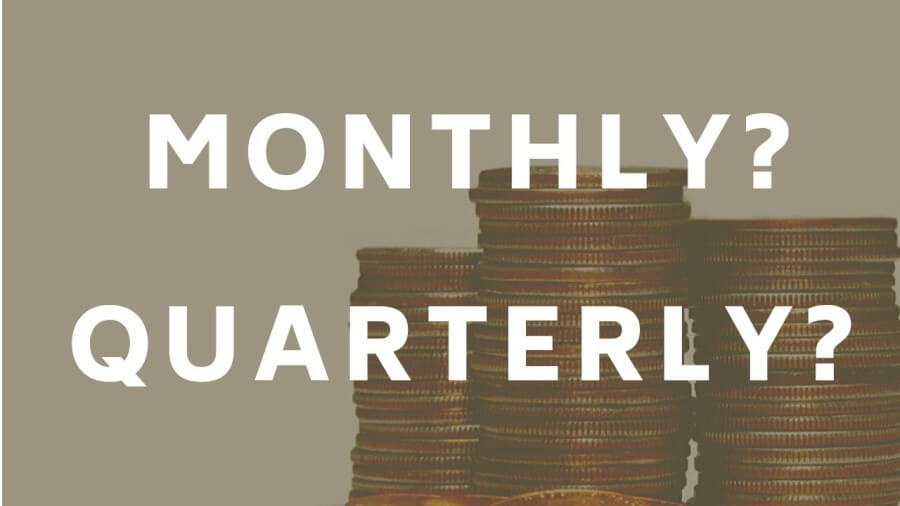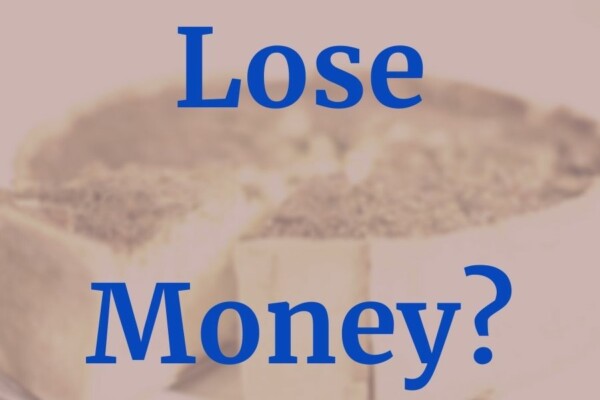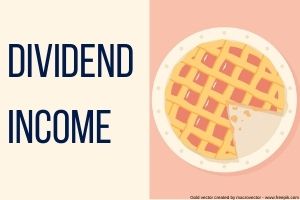Video transcript
00:00 so what are the advantages of monthly
00:03 dividends over quarterly dividends are
00:05 they even advantages at all well let’s
00:08 take a look at some of the advantages
00:10 and disadvantages and see if they hold
00:13 up so the first advantage is and by the
00:21 way a link to my post here will be down
00:24 in the description the first advantage
00:27 is steadier income so to speak and
00:30 that’s probably not the best terminology
00:34 to say steady because paying quarterly
00:36 is steady just as monthly or weekly or
00:39 annually would be probably a better word
00:44 would be more frequent okay so obviously
00:48 month monthly comes around more
00:51 frequently than quarterly and the appeal
00:54 of monthly dividends is that in large
00:58 part because it coincides with expenses
01:01 things like rent mortgage utilities
01:05 vehicle payments so from an income
01:09 standpoint it coincides better with
01:13 expenses now the quarterly dividend
01:18 paying whether it be stocks ETFs mutual
01:21 funds or that well okay not necessarily
01:25 ETFs or mutual funds the stocks in
01:28 particular paying there are plenty that
01:31 pay dividends in the off months okay
01:34 what I mean by that is your your typical
01:36 months for quarter end are going to be
01:39 March June September and December okay
01:41 but there are other stocks with
01:45 different fiscal year ends and
01:47 accordingly pay dividends in the off
01:52 months we’ll call them
01:53 so you can invest in a typical dividend
01:57 paying stock that paid in March June
01:58 September December ok then you can also
02:01 pay
02:02 sorry invest in another stock that paid
02:05 a dividend in February May August and
02:07 November finally see where I’m going
02:09 here is you could invest in a stock that
02:12 pays in January April July and October
02:15 yeah be staggering months and therefore
02:19 you would have monthly dividend payments
02:22 now of course all that is going to
02:25 depend on how much you invest in the
02:28 stock what it pays in terms of a
02:31 dividend what its yield is and so forth
02:34 and so on so it’s not going to be as
02:39 from a dollar amount standpoint probably
02:42 as as consistent but the point is that
02:46 you could achieve a similar sort of
02:51 thing as investing in a monthly dividend
02:53 paying stock with quarterly dividend
02:56 paying stocks so you know the one of the
03:00 problems here is that’s going to take
03:04 three times to research you know whereas
03:06 you could research one monthly dividend
03:10 paying stock you know in order to do the
03:14 staggering thing you would have to
03:16 research three stocks now one site you
03:22 might take a look at to get an idea of
03:24 when dividends are paid is the Nasdaq
03:29 dividend calendar there might be a
03:31 better reference out there but this
03:35 allows you to go forward and back in
03:37 time I forget how far back but at least
03:43 the ways in order to see the exact
03:45 payment date for different dividend
03:49 stocks and ETFs are included on here so
03:53 the benefit there being if this is what
03:57 you want to do to stagger your quarterly
03:59 dividend payments you could even if you
04:02 wanted to you’re gonna kind of
04:05 handcuff yourself a little bit but you
04:08 could narrow it down to the the middle
04:10 of the month versus the end of the month
04:12 or the beginning of the month you know
04:14 if you just chose to research particular
04:16 companies so you know there’s probably a
04:23 better resource for like I said for
04:25 narrowing down I can find anywhere that
04:27 you can necessarily screen companies
04:29 based on when they paid a dividend or
04:32 more specifically if they paid in those
04:34 off months but certainly not to say one
04:38 doesn’t exist now as far as mutual funds
04:41 go I couldn’t find a neutral in calendar
04:47 most mutual funds that that I found just
04:52 a small sampling there are a lot of
04:53 mutual funds but most of them the paid
04:56 quarterly as opposed to monthly there is
04:59 a good amount that do pay monthly and my
05:03 previous video was on that so check that
05:05 out and that’s also there’s also a post
05:07 on the site invest some money calm most
05:13 of them paid in a typical March June
05:14 September December
05:16 mutual funds did so there might exist
05:19 those that pay in the off months but in
05:24 order to find them you’re probably gonna
05:26 have to dig around they’re probably the
05:29 exception not the rule
05:30 so like I mentioned earlier the nasdaq
05:33 dividend calendar does include ETFs but
05:37 again just from my my little bit of
05:40 poking around sampling I couldn’t find
05:44 any dad ETFs that paid in those off
05:47 months either so that the whole
05:49 staggering dividend thing is probably
05:51 going to be best executed with stocks
05:54 not so much with ETFs mutual funds but
05:57 like I said ETFs and mutual funds is a
05:59 kind of cover in my previous video and
06:02 previous post there are a lot of options
06:05 there in terms of those that do pay
06:08 monthly so the one of the biggest
06:16 strengths advantages pros whatever you
06:19 want to call it of monthly dividends is
06:24 the notion that de compound quicker okay
06:28 and if you’ve spent any time looking at
06:34 this subject on other YouTube videos on
06:36 other blog posts you’ve no doubt come
06:40 across that so intuitively that makes
06:43 sense all right you know the notion that
06:47 a dollar today is worth more than a
06:49 dollar tomorrow is what finance is built
06:53 on okay but that’s you know that’s what
07:02 we’re assuming in theory but I wanted to
07:04 run a little experiment to see if it
07:06 applied in practice okay you know for
07:10 sure if all investments increased in a
07:13 linear fashion and hopefully I’m
07:15 pointing the right way it’s kind of like
07:17 a mirror image thing but went up
07:19 straight like that over time you know
07:22 you’d always be buying in at a lower
07:24 amount and therefore buying more a lot
07:27 like dollar cost averaging okay works
07:31 great if the investments going up not so
07:34 great if it’s going down you know if
07:35 it’s going up your average costs can be
07:37 lower it’s going down average costs
07:39 going to be higher same thing applies to
07:43 dividend reinvesting through a drip okay
07:48 so probably if you’re watching this you
07:52 haven’t been to my site yet and it’s
07:54 still in its infancy but what I like to
07:59 do with any investing principle is try
08:06 to create a model for it
08:08 and test things out you know that create
08:13 as an accurate the model I can and see
08:16 how what what I might assume or what the
08:20 conventional wisdom might be how it
08:23 plays out when we test it against things
08:26 I’ve actually
08:27 past okay so I did the same with this
08:31 particular notion that monthly stocks
08:35 dividend-paying stocks compound more
08:39 favorably than quarterly dividend paying
08:41 stocks so I looked at it from two
08:44 different angles I chose three quarterly
08:46 dividend paying stocks caterpillar
08:48 Archer Daniels Midland ADM and Abbott
08:51 Labs and then I chose three monthly
08:55 dividend paying stocks Gladstone
08:59 Investment Corporation Realty income
09:02 corporation and solar senior capital
09:05 okay so the quarterly dividend paying
09:07 stocks I looked at theoretically what
09:12 the compounding effect would be if they
09:14 paid monthly for the monthly paying
09:17 monthly dividend paying stocks I look
09:19 tia retic lee what the compounding
09:21 effect would be if they pay quarterly
09:23 okay it’s kind of both sides of the coin
09:25 there with any model you have to make
09:28 certain assumptions and acknowledge that
09:31 there’s certain shortcomings of it so I
09:34 went back in time five years with this
09:36 model okay from I forget what the exact
09:39 date was but it’s April 24 something
09:41 like that and so if you’ve ever done
09:48 anything similar or any look today in my
09:50 other post you know a big part of the
09:53 results your model are gonna be when did
09:55 you start it when did you end it you you
09:58 could change that by shift that by a
10:00 week and get completely different
10:02 results okay that’s just the nature of
10:06 the market you know it’s it’s all about
10:10 the price you you bought in at all about
10:13 the price you sold that and depending on
10:15 the volatility of the investment you
10:18 know whether you’re looking at something
10:19 like this or something from a technical
10:22 analysis standpoint so you know it
10:26 matters that I can swing wildly your buy
10:28 price and your sell price and therefore
10:30 and your results particularly over the
10:33 five year period between luckily so you
10:36 know
10:37 maybe the model should have been 10
10:39 years 20 years 6 years 2 years 5 or 5
10:43 and a half years 4 years and a month I
10:46 mean you know who’s the say okay
10:48 I picked five years it’s a nice round
10:50 number I feel like five years gives an
10:52 investment an opportunity to kind of
10:54 show it stuff you know it’s it’s not so
10:58 short that it doesn’t include kind of
11:02 certain cyclical on aspects of the
11:06 market if such a thing exists it you
11:10 know it’s not so long that it’s
11:12 impractical I mean yeah we’d all love to
11:14 say that we bought in at Amazon or you
11:20 know Microsoft or you know whatever
11:24 whatever whenever you’re watching this
11:26 is 10 years from now whatever the you
11:28 know stock that we all wish would have
11:30 got in you know at the ground floor on
11:33 you know five years is is a long-term
11:39 investment
11:40 you know maybe not warm up it long but
11:42 it is long-term okay so anyways into the
11:46 model so what have we do let’s take a
11:48 look at okay so day one of the model all
11:51 right we had five thousand dollars okay
11:54 there are two different scenarios and
11:57 what we did is bought as many shares as
12:00 possible of each stock and the rest went
12:04 into cash because we’re assuming that no
12:07 fractional shares were bought initially
12:10 but going forward when the dividends
12:13 paid you know for that instance this
12:16 right here is 60 cent dividend paid on
12:21 what was 49 shares said in most the
12:25 dividend reinvestment plans particularly
12:27 those directly with the company if I
12:28 understand right you can buy fractional
12:31 shares so the entire dividend was put
12:33 towards shares it was not added to cash
12:35 you’ll see these quarterly cash amounts
12:37 monthly cash amounts they’re going to be
12:38 the same throughout the entire model
12:41 here
12:42 like for Caterpillar here it’s 2895 the
12:44 whole whole time but you see these every
12:47 time a dividend is paid whether it be
12:49 monthly whether it be quarterly a
12:52 fractional amount of shares is added
12:54 okay I see no taxes or commissions for
13:01 taken into consideration some of my
13:03 other models on investing money comm I
13:05 do particularly the technical analysis
13:08 models I do take those into
13:09 consideration because of the frequency
13:11 of trading but in this case like I said
13:14 it was just basically the shares the
13:16 initial shares bought once it’s dividend
13:18 reinvestment plan you know so we just
13:23 took those out of consideration for
13:25 simplicity sake okay so we’ve got okay
13:34 here’s the monthly I’m site the
13:35 quarterly dividend stocks give
13:37 Caterpillar idiom Abbott Labs here’s the
13:40 monthly ones and it just switched around
13:42 one thing of note real quick in the
13:45 model okay so the actual dividend date
13:49 yeah so like here’s all the quarterly
13:52 dates here and the amount of the
13:53 dividend for this particular stock I had
13:57 to of course assume what the monthly
13:59 dividend date would be because they
14:02 didn’t pay monthly dividends so I had to
14:03 assume and what I did in essence is you
14:08 know look that if quarterly date was
14:11 April 11th I just went back two months
14:13 okay and divided dividends into thirds
14:16 you know so between like February 11th
14:20 March 11th and in April 11th of course
14:23 the actual date if one of these days
14:26 fell on a Saturday or Sunday it was a
14:29 Saturday
14:30 I’d move it back to a Friday it was a
14:31 Sunday they move it forward to a Monday
14:33 okay again you know he’s modeled when
14:36 you start and stop when you buy and sell
14:39 it matters all right so you know that
14:44 was kind of the most logical way I
14:45 figure I could go about picking a day
14:49 you know because otherwise the results
14:53 might skew one way or the other
14:57 that’s another assumption that was made
14:59 in the in the model there and then I
15:07 think for the monthly it was a little
15:10 easier because we just paid rather than
15:13 this monthly amount here that was all
15:15 just group to the same day for the
15:18 quarterly the theoretical quarterly as
15:20 the last day of the month okay pretty
15:25 straightforward the you know the same
15:29 general analysis just kind of flipped on
15:33 its head between the monthly paying
15:35 stocks and the quarterly stocks so
15:36 you’ll notice in these columns here I
15:38 got them for all all these different
15:41 deals here and it basically says all
15:46 these different companies and the X
15:48 basically implies when the monthly value
15:50 is greater than the quarterly value and
15:54 you’ll see how that all shakes out here
16:00 actually next in this table so here are
16:02 the results
16:03 okay across the six stocks so we’ve got
16:06 the ending monthly total value again for
16:09 these sorry for Caterpillar ADM and
16:13 habit that’s gonna be theoretical the
16:16 ending monthly total value sir game oh
16:18 and Sons it’s gonna be theoretical for
16:23 ending quarterly value okay so here we
16:27 are in nearly every instance except
16:30 Archer Daniels Midland got the total
16:33 ending value of the investment for for
16:36 the monthly reinvesting was higher but
16:39 we’re talking by just marginal amounts
16:42 okay so here’s the dollar amount and a
16:46 percentage difference okay so the
16:48 biggest one was sons over five years a
16:53 whopping 0.54% difference in return so
16:59 the other one thing sorry real quick on
17:01 a point out is the days that the month
17:03 was great in the quarter that says
17:05 axes okay just shows because again it
17:07 depends on what day the analysis ended
17:10 not every single analysis had monthly
17:15 always higher than quarterly okay you
17:18 can see sons mostly 99% of the days the
17:22 monthly total value was higher than then
17:24 quarterly total value but not every
17:26 single day so again depends when the
17:27 analysis ended can’t emphasize that
17:30 enough it always depends you know but
17:35 anyhow you can see in again in most of
17:38 these cases with the exception of
17:40 Caterpillar
17:40 only 28% of the days was monthly higher
17:44 than quarterly about half an alkyl ADM
17:47 but the rest of them predominantly the
17:50 monthly balance was always higher than
17:51 quarterly okay so I kind of covered all
17:57 that and you know the conclusion I would
18:00 draw there is that monthly has the
18:04 potential to compound more favorably
18:07 just by its very very nature but you
18:12 know the my little sample there there
18:16 are plenty of other monthly paying
18:19 stocks out there besides the three that
18:21 I look to have but just based on this
18:24 little sample I wouldn’t choose a
18:27 monthly dividend paying stocks solely on
18:30 the premise that it’s gonna compound
18:32 more favorably if you want to choose it
18:34 because it gives you more frequent
18:36 income coincides with your expenses
18:39 better great but the you know the whole
18:44 compounding thing as far as I can tell
18:46 from my little bit of research is
18:50 negligible it’s just a tiny advantage
18:52 okay so with the advantages outweigh
18:54 let’s talk about the disadvantages real
18:56 quick here being the disadvantages for a
19:00 monthly dividends are the same as a
19:01 disadvantages for quarterly they’re just
19:04 kind of compounded a little bit because
19:08 obviously it’s paid more often and the
19:13 one of the knocks on dividends has
19:15 always been that it implies that
19:18 there the company paying a dividend
19:21 doesn’t have attractive investment
19:22 options itself so it’s just giving the
19:25 cash to the shareholders okay that
19:28 basically you shouldn’t expect much in a
19:31 way of capital gains because there’s not
19:35 attractive investments to be made within
19:39 for the company to make it itself so you
19:47 know a lot of that comes down to
19:49 management in your faith in their
19:52 ability to earn above average returns
19:56 you know it’s a matter of can you know
20:00 if you don’t don’t need the income if
20:03 you need to income the income okay but
20:06 if you’re indifferent then again this is
20:10 just one of the knocks kind of dividends
20:13 then you know you would want you would
20:19 want whatever is more favorable them to
20:21 reinvest it or for they to give it to
20:24 you so you can reinvestment or pay your
20:25 bills or whatever it may be I think that
20:29 there’s kind of a parallel though you
20:32 know I and as a rule of thumb I like the
20:34 but in stocks because it you know it’s
20:36 it’s all about that you know kicking out
20:41 that cash there’s something tangible
20:43 about it because paper gains are great
20:47 you know we all feel good and we look at
20:52 our investments and they’ve gone up X
20:55 percent and they’re worth more today
20:57 than they were yesterday that’s fine and
20:58 good but until it’s cashed out those
21:02 gains aren’t locked in so you know I
21:06 draw the parallel between you know a
21:08 company that pays dividends versus
21:12 reinvesting in itself and a company
21:15 itself receding cash versus making a
21:17 sale you know if a company makes a sale
21:19 that’s fine I’m good but until they
21:21 actually get that cash flow and and pay
21:23 their own bills with it you know it’s
21:25 it’s just a paper game it’s it’s
21:28 intangible and
21:30 it’s fine and good but it’s not cash all
21:34 right now one of the other knocks on
21:35 dividends in general not necessarily
21:37 monthly is taxes and I think it’s a
21:40 little more legitimate because dividends
21:44 are taxed
21:45 well the taxes income I couldn’t find a
21:47 clear answer on this if I’m going to be
21:49 completely honest
21:49 their taxes income or their qualified
21:54 dividends their tax at capital gains
21:56 rates and there’s just a lack of good
21:58 information on this and if I can ever
22:00 get my hands on that information I might
22:02 make a post on it because the Internet’s
22:05 are obviously hungry for this sort of
22:07 information it you know I’ve found
22:11 plenty of posts on it you know from
22:14 reputable sites fool I think
22:16 investopedia and everything but their
22:18 answer always seem to be the same that
22:21 oh well you’ll know if it’s quality or
22:23 not when you get your 1099 div at the
22:25 end of the air and that’s like that
22:26 doesn’t allow you to make any sort of
22:29 decision you know and there’s a big
22:32 difference in taxes between whether it’s
22:34 ordinary dividends taxed at income rates
22:38 or qualified texted capital gains rates
22:40 so anyway the whole point of this is if
22:46 the if the company pays you dividend
22:50 you’re gonna pay taxes on it that’s a
22:53 given more or less and that is one of
22:57 the downfalls if the company did have
22:59 potentially attractive investment
23:01 options in and of it to reinvest in
23:04 itself it would be able to invest a
23:07 dollar so to speak but you as an
23:10 individual you’re gonna get that dollar
23:12 you can owe taxes on the most you’ll be
23:14 able to reinvest is eighty five cents at
23:17 a fifteen percent capital gains rate
23:20 qualified dividends rate so that’s that
23:25 is a real shortfall of dividend paying
23:30 versus reinvesting company and the last
23:33 disadvantage we’ll go over is just the
23:34 potential cash crunch so I have a sister
23:38 side spreadsheets for business calm
23:41 that’s it there you’ll notice it looks
23:44 suspiciously a lot like invested money
23:49 calm I didn’t get creative with a
23:52 different theme or anything but hang on
23:55 so this site that I made for basically
24:01 finance for small businesses you know
24:04 corporate flacon so to speak for small
24:06 businesses and you know when the
24:08 recurring things and I go over there is
24:10 cash flow the importance of cash flow
24:13 touched on it just a moment ago cash
24:15 flow okay all the sales in the world
24:18 don’t mean unless you get your cash
24:21 when you need it okay it’s all about
24:24 when it comes in and how fast it comes
24:28 in when it goes out okay three whether
24:31 you own a small business or investing in
24:34 dividend paying stocks or futures Forex
24:40 crypto whatever okay all investments
24:44 have three main components that related
24:50 to performance three things just three
24:52 things that matter okay cash in cash out
24:56 in time okay that’s it so it’s the same
25:01 thing with a with a business and once a
25:06 business page you would dividend it that
25:10 money’s gone they can’t come back to you
25:12 you know like hey mr. an but investor
25:15 you know look we kind of overextended
25:18 ourselves can we get a little bit of
25:20 last month or last quarter was dividend
25:22 back you know I can’t do that that
25:24 money’s gone so you know it all comes
25:26 down to management if they are confident
25:30 and if they plan and then they in most
25:33 cases should the management board of
25:36 directors and everything before they pay
25:37 a dividend or you know have a good grasp
25:40 on their financial budgeting and the
25:43 cash flow situation they’re not going to
25:45 put themselves in a situation where
25:49 paying a dividend leads them into some
25:53 sort of downward spiral
25:55 and leads to their insolvency so that’s
25:59 about it for the post I probably went a
26:01 little longer than I hope to that’s what
26:03 I do but yeah
26:06 okay so monthly versus quarterly
26:07 dividends I gave you a couple of things
26:10 that I saw as advantages disadvantages
26:11 of monthly dividends over quarterly if I
26:15 missed anything okay
26:18 check out the post put it down in the
26:20 comments
26:20 then down the comments on YouTube also
26:23 and you know I’d be interested to hear
26:26 what your conclusions were from the
26:31 little model a little sample I did in
26:33 terms of testing the monthly dividend
26:35 compounding versus quarterly you know if
26:38 you see something maybe that I didn’t
26:39 mention or overlooked or that let me
26:42 know and finally if you know the
26:44 difference between ordinary and
26:45 qualified dividends from you know well
26:48 means let me know that too thanks for
26:50 watching see













